Failure Modes of Reinforced Concrete Beams Strengthened in Flexure with Externally Bonded Aramid Fiber-Reinforced Polymer Sheets under Impact Loading
Abstract
:1. Introduction
2. Experimental Overview
3. Experimental Results and Discussions
3.1. Static Loading Tests
3.1.1. Static Load-Deflection Curve
3.1.2. Strain Distribution of the AFRP Sheet
3.1.3. Crack Patterns for Beams after Static Loading Tests
3.2. Drop-Weight Impact Tests
3.2.1. Time Histories of the Impact Force, Reaction Force, and Deflection
3.2.2. Crack Patterns of the RC Beams
3.2.3. Strain Distribution of the AFRP Sheet and the Crack Pattern near the Loading Point
3.2.4. Relationship between the Maximum Response Values and Impact Energy
3.2.5. Failure Modes of the RC Beams Strengthened in Flexure
4. Conclusions
- From the static loading test results, the failure mode of the strengthened RC beams with AFRP sheets was classified into two types as in the previous research [31]: flexural compression failure and debonding failure. Therefore, based on the calculated bending moment capacity ratio My/Mu, the failure mode of strengthened RC beams can be predicted.
- From the impact loading test results, the maximum and residual displacement of the strengthened beams can be restrained by up to 35% and 85%, respectively, compared with nonstrengthened beams.
- The maximum/residual displacement of the RC beams with/without AFRP sheets linearly increased with the input impact energy.
- The failure mode of the strengthened RC beams under impact loading was classified into two types depending on the sheet volume: sheet rupturing and sheet debonding. The former corresponds to the flexural compression failure mode, while the latter corresponds to the debonding failure mode under static loading.
- The failure mode of RC beams changed from flexural failure under static loading to flexural–shear failure when under impact loading, regardless of whether the RC beams were strengthened with the AFRP sheets.
- The debonding of the AFRP sheet of the strengthened RC beams might not be improved by increasing the sheet volume, regardless of the case of static or impact loading.
- When the input impact energy was greater than or equal to 7.33 kJ (corresponding to the drop height H = 2.5 m), the tested strengthened beams failed through sheet debonding and/or rupturing.
Author Contributions
Funding
Data Availability Statement
Acknowledgments
Conflicts of Interest
References
- Ahmed, E.; Sobuz, H.R.; Sutan, N.M. Flexural Performance of CFRP Strengthened RC Beams with Different Degrees of Strengthening Schemes. Int. J. Phys. Sci. 2011, 6, 2229–2238. [Google Scholar]
- Attari, N.; Amziane, S.; Chemrouk, M. Flexural Strengthening of Concrete Beams Using CFRP, GFRP and Hybrid FRP Sheets. Constr. Build. Mater. 2012, 37, 746–757. [Google Scholar] [CrossRef]
- More, R.U.; Kulkarni, D.B. Flexural Behavioural Study on RC Beam with Externally Bonded Aramid Fiber Reinforced Polymer. Int. J. Res. Eng. Technol. July 2014, 3, 316–321. [Google Scholar]
- Chen, W.; Pham, T.M.; Sichembe, H.; Chen, L.; Hao, H. Experimental Study of Flexural Behaviour of RC Beams Strengthened by Longitudinal and U-Shaped Basalt FRP Sheet. Compos. Part B Eng. 2018, 134, 114–126. [Google Scholar] [CrossRef] [Green Version]
- Raval, C.; Shah, S.; Machhi, C. Experimental Study on Shear Behaviour of RC Beam Strengthened by AFRP Sheet. Int. J. Res. Writ. 2020, 3, 62–68. [Google Scholar]
- Madotto, R.; Van Engelen, N.C.; Das, S.; Russo, G.; Pauletta, M. Shear and Flexural Strengthening of RC Beams Using BFRP Fabrics. Eng. Struct. 2021, 229, 111606. [Google Scholar] [CrossRef]
- Panahi, M.; Zareei, S.A.; Izadi, A. Flexural Strengthening of Reinforced Concrete Beams through Externally Bonded FRP Sheets and near Surface Mounted FRP Bars. Case Stud. Constr. Mater. 2021, 15, e00601. [Google Scholar] [CrossRef]
- American Concrete Institute. ACI Committee 440 Guide for the Design and Construction of Externally Bonded FRP Systems for Strengthening Concrete Structures; American Concrete Institute: Farmington Hills, MI, USA, 2017; ISBN 978-1-945487-59-0. [Google Scholar]
- Mostofinejad, D.; Mahmoudabadi, E. Grooving as Alternative Method of Surface Preparation to Postpone Debonding of FRP Laminates in Concrete Beams. J. Compos. Constr. 2010, 14, 804–811. [Google Scholar] [CrossRef]
- Mostofinejad, D.; Shameli, M. Performance of EBROG Method under Multilayer FRP Sheets for Flexural Strengthening of Concrete Beams. Procedia Eng. 2011, 14, 3176–3182. [Google Scholar] [CrossRef] [Green Version]
- Mostofinejad, D.; Tabatabaei Kashani, A. Experimental Study on Effect of EBR and EBROG Methods on Debonding of FRP Sheets Used for Shear Strengthening of RC Beams. Compos. Part B Eng. 2013, 45, 1704–1713. [Google Scholar] [CrossRef]
- Mostofinejad, D.; Shameli, S.M. Externally Bonded Reinforcement in Grooves (EBRIG) Technique to Postpone Debonding of FRP Sheets in Strengthened Concrete Beams. Constr. Build. Mater. 2013, 38, 751–758. [Google Scholar] [CrossRef]
- Mostofinejad, D.; Hosseini, S.A.; Razavi, S.B. Influence of Different Bonding and Wrapping Techniques on Performance of Beams Strengthened in Shear Using CFRP Reinforcement. Constr. Build. Mater. 2016, 116, 310–320. [Google Scholar] [CrossRef]
- Buchan, P.A.; Chen, J.-F. Blast Resistance of FRP Composites and Polymer Strengthened Concrete and Masonry Structures—A State-of-the-Art Review. Compos. Part B Eng. 2007, 38, 509–522. [Google Scholar] [CrossRef]
- Muszynski, L.; Purcell, M. Composite Reinforcement to Strengthen Existing Concrete Structures against Air Blast. J. Compos. Constr. 2003, 7, 93–97. [Google Scholar] [CrossRef]
- Kishi, N.; Komuro, M.; Kawarai, T.; Mikami, H. Low-Velocity Impact Load Testing of RC Beams Strengthened in Flexure with Bonded FRP Sheets. J. Compos. Constr. 2020, 24, 04020036. [Google Scholar] [CrossRef]
- Erki, M.A.; Meier, U. Impact Loading of Concrete Beams Externally Strengthened with CFRP Laminates. J. Compos. Constr. 1999, 3, 117–124. [Google Scholar] [CrossRef]
- Tang, T.; Saadatmanesh, H. Behavior of Concrete Beams Strengthened with Fiber-Reinforced Polymer Laminates under Impact Loading. J. Compos. Constr. 2003, 7, 209–218. [Google Scholar] [CrossRef]
- Pham, T.; Hao, H. Impact Behavior of FRP-Strengthened RC Beams without Stirrups. J. Compos. Constr. 2016, 20, 04016011. [Google Scholar] [CrossRef]
- Pham, T.; Hao, H. Behavior of Fiber-Reinforced Polymer-Strengthened Reinforced Concrete Beams under Static and Impact Loads. Int. J. Prot. Struct. 2016, 8, 3–24. [Google Scholar] [CrossRef]
- Cotsovos, D. A Simplified Approach for Assessing the Load-Carrying Capacity of Reinforced Concrete Beams under Concentrated Load Applied at High Rates. Int. J. Impact Eng. 2010, 37, 907–917. [Google Scholar] [CrossRef]
- Hamed, E.; Rabinovitch, O. Dynamic Behavior of Reinforced Concrete Beams Strengthened with Composite Materials. J. Compos. Constr. 2005, 9, 429–440. [Google Scholar] [CrossRef]
- Goldston, M.; Remennikov, A.; Sheikh, M. Experimental Investigation of the Behaviour of Concrete Beams Reinforced with GFRP Bars under Static and Impact Loading. Eng. Struct. 2016, 113, 220–232. [Google Scholar] [CrossRef] [Green Version]
- Rabinovitch, O. Dynamic Debonding in Concrete Beams Strengthened with Composite Materials. Int. J. Solids Struct. 2012, 49, 3641–3658. [Google Scholar] [CrossRef] [Green Version]
- Pham, T.; Hao, H. Review of Concrete Structures Strengthened with FRP Against Impact Loading. Structures 2016, 7, 59–70. [Google Scholar] [CrossRef] [Green Version]
- Tang, T.; Saadatmanesh, H. Analytical and Experimental Studies of Fiber-Reinforced Polymer-Strengthened Concrete Beams under Impact Loading. ACI Struct. J. 2005, 102, 139–149. [Google Scholar]
- Zhan, T.; Wang, Z.; Ning, J. Failure Behaviors of Reinforced Concrete Beams Subjected to High Impact Loading. Sixth Int. Conf. Eng. Fail. Anal. 2015, 56, 233–243. [Google Scholar] [CrossRef]
- White Timothy, W.; Soudki Khaled, A.; Erki, M.-A. Response of RC Beams Strengthened with CFRP Laminates and Subjected to a High Rate of Loading. J. Compos. Constr. 2001, 5, 153–162. [Google Scholar] [CrossRef]
- Wang, W. Flexural Behaviour of FFRP Wrapped CFRC Beams under Static and Impact Loadings. Int. J. Impact Eng. 2017, 111, 46–54. [Google Scholar] [CrossRef]
- Liu, Y.; Jiang, Z.; Wen, H.M. Predicting Impact Induced Delamination of FRP Laminates. Int. J. Impact Eng. 2019, 137, 103436. [Google Scholar] [CrossRef]
- Kishi, N.; Mikami, H.; Matsuoka, K.G.; Kurihashi, Y. Failure Behavior of Flexural Strengthened RC Beams with AFRP Sheet. In FRPRCS-5: Fibre-Reinforced Plastics for Reinforced Concrete Structures Volume 1; Thomas Telford Publishing: London, UK, 2001; pp. 87–95. ISBN 978-0-7277-3647-5. [Google Scholar]
- JSCE (Japan Society of Civil Engineers). Standard Specification for Concrete Structures-2007 Design; JSCE: Tokyo, Japan, 2007; ISBN 978-4-8106-0752-9. [Google Scholar]
- JSCE (Japan Society of Civil Engineers). Standard Specification for Concrete Structures-2017 Design in Japanese; JSCE: Tokyo, Japan, 2018; ISBN 978-4-8106-0777-2. [Google Scholar]
- Fibex. Material Properties for Unidirectional AFRP Sheets; Fibex: Tokyo, Japan, 2014. [Google Scholar]
- JIS K 7165; Plastics—Determination of Tensile Properties—Part 5.Test Conditions for Unidirectional Fibre-Reinforced Plastic Composites. Japanese Standards Association: Tokyo, Japan, 2008.
- Kaklauskas, G.; Bacinskas, D.; Šitnkus, R. Deflection Estimates of Reinforced Concrete Beams by Different Methods. Statyba 1999, 5, 258–264. [Google Scholar] [CrossRef] [Green Version]
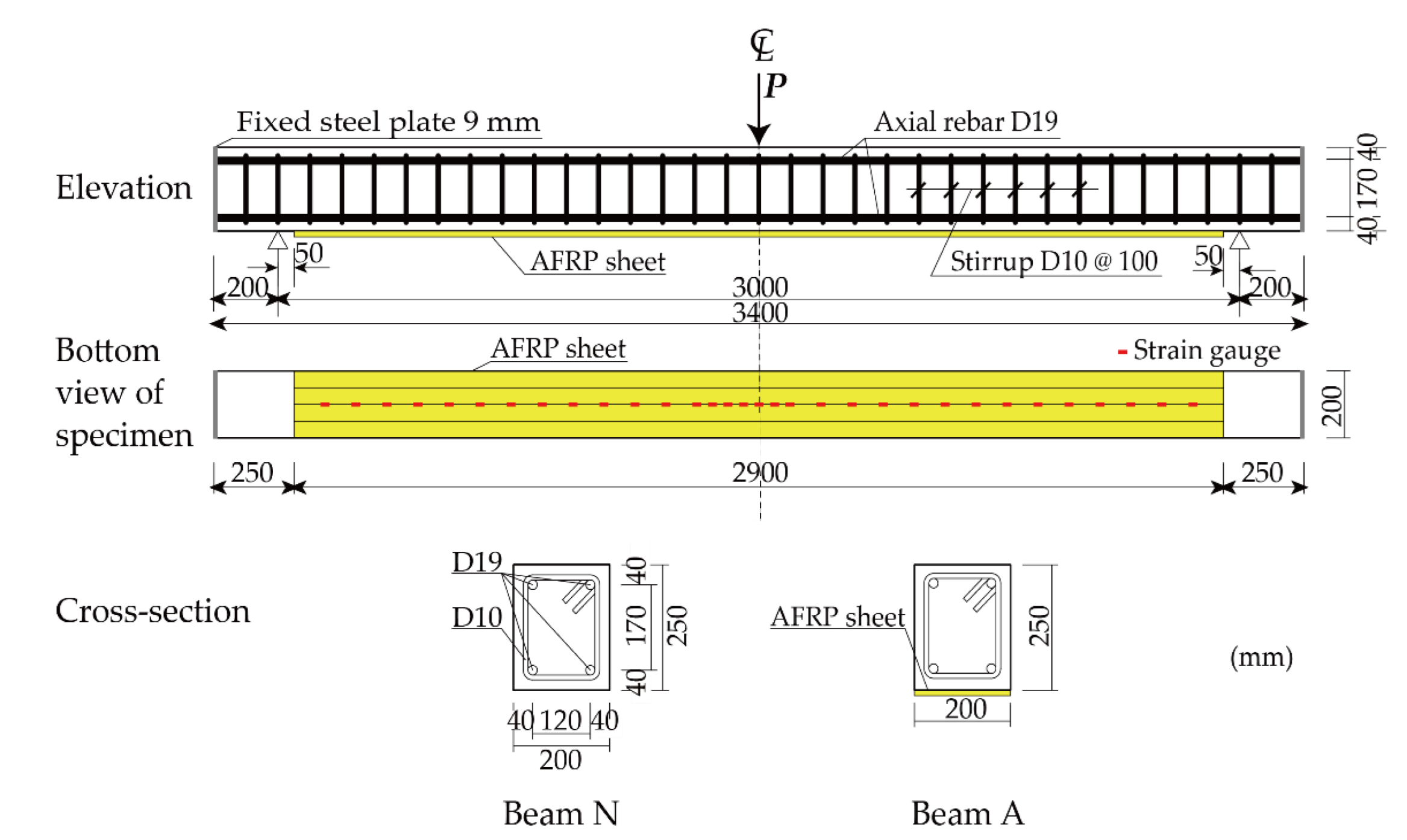
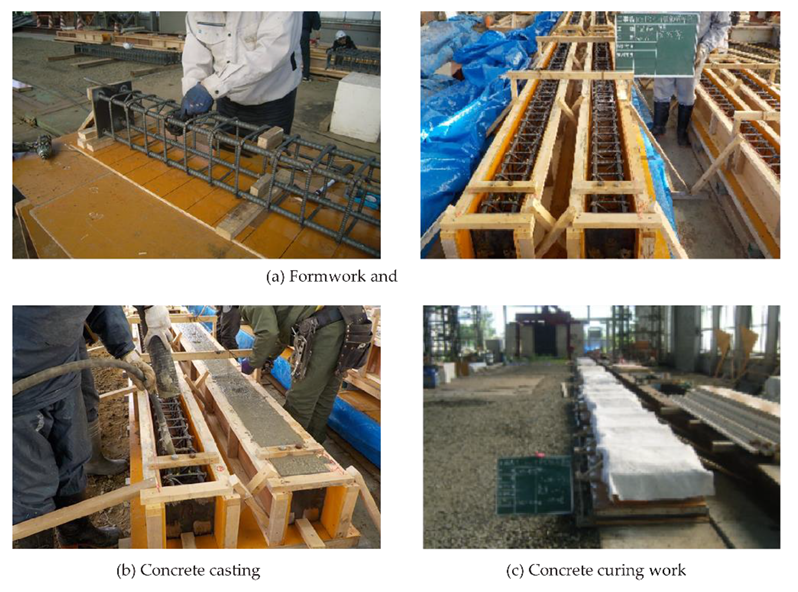
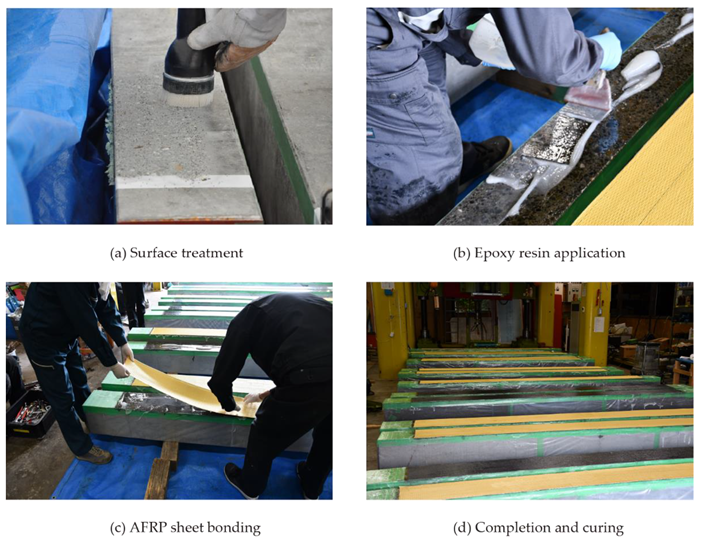


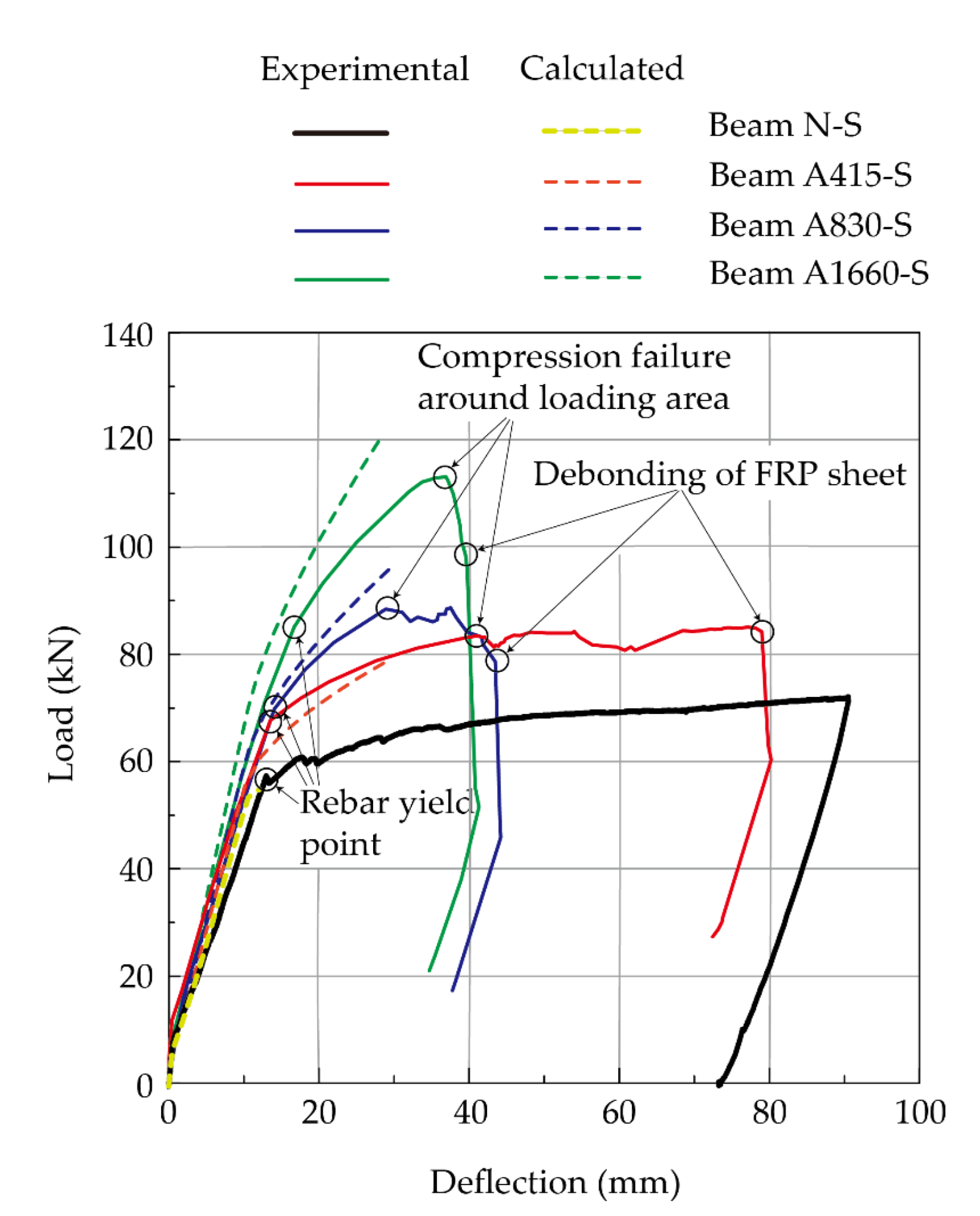



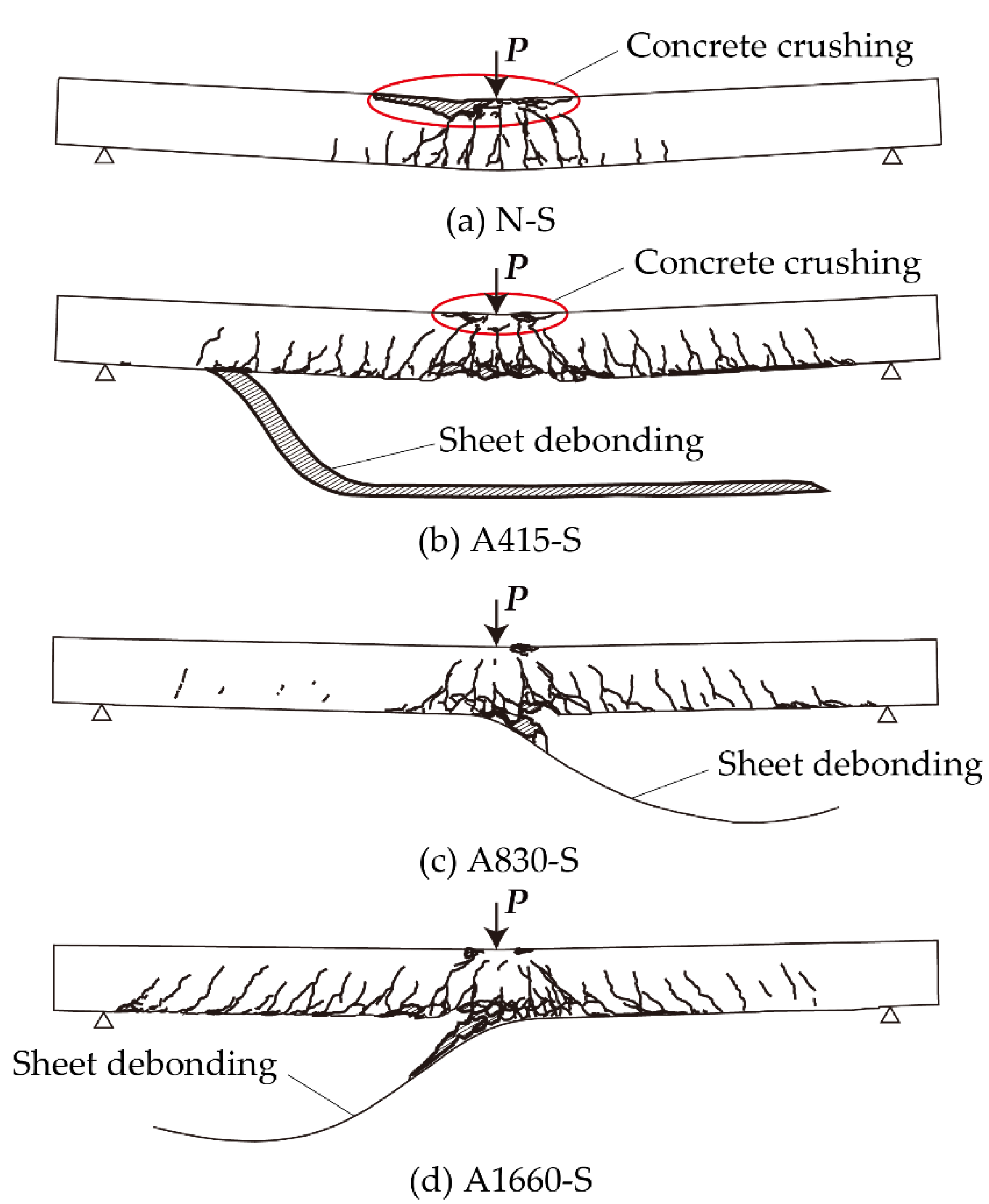

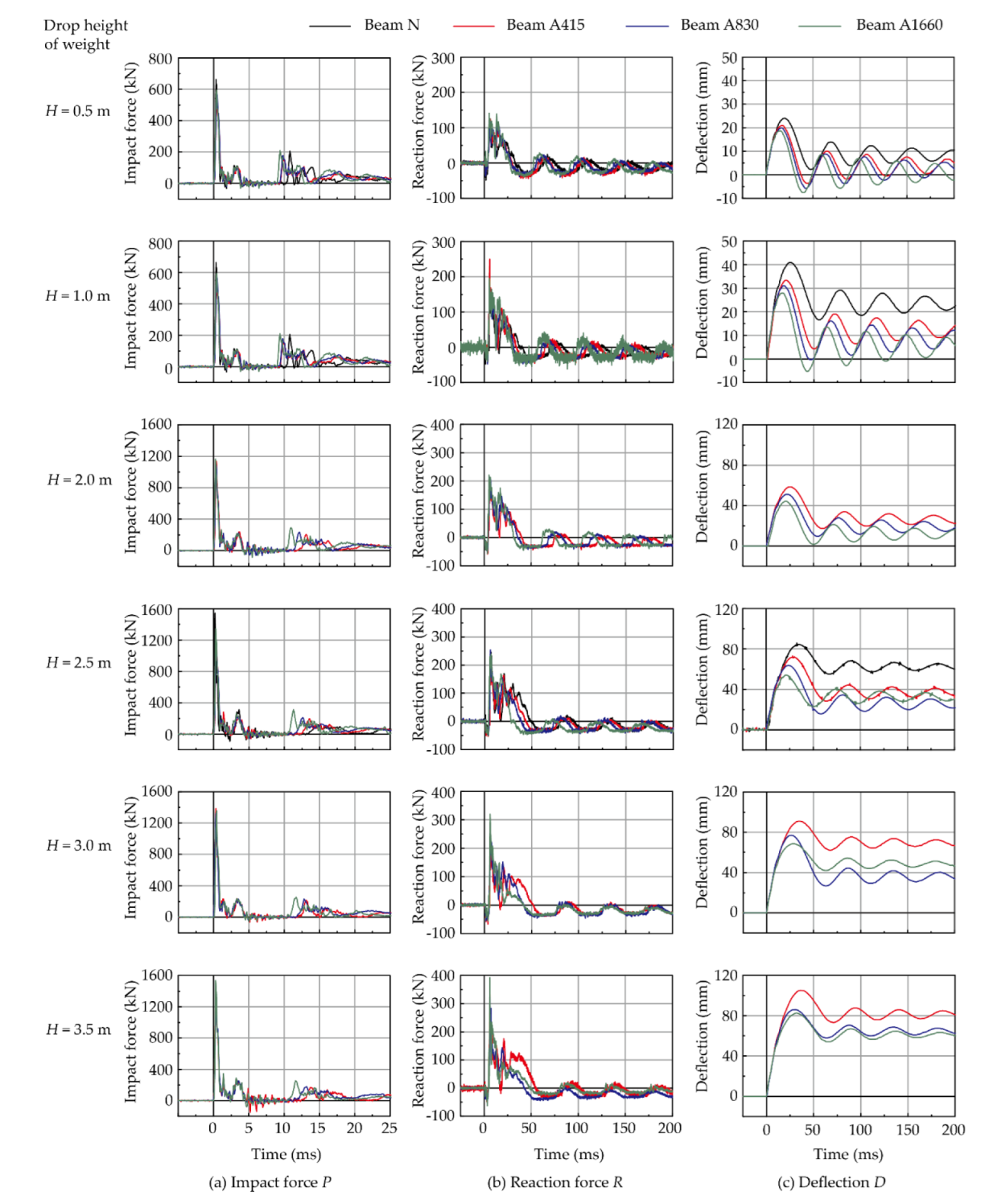
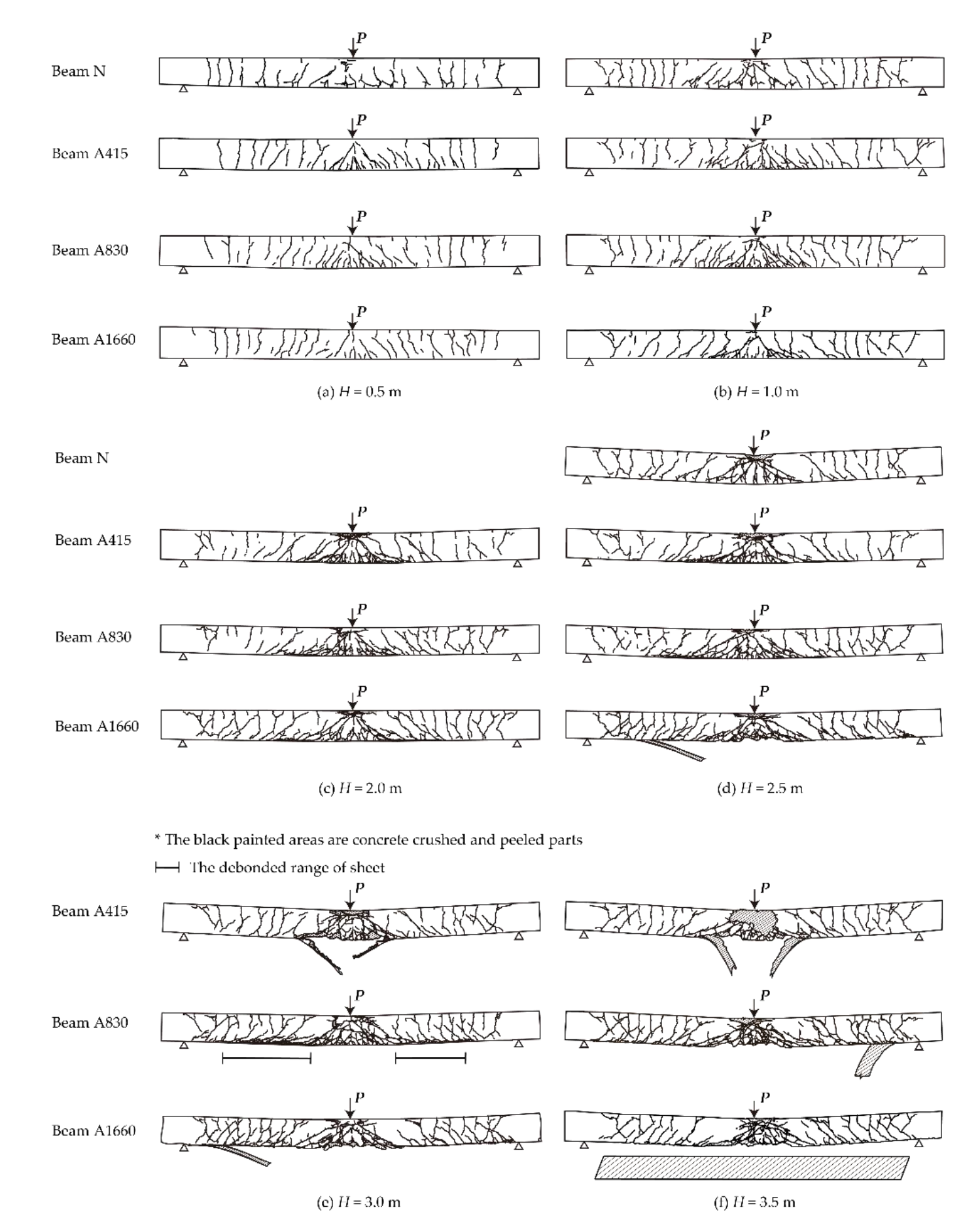


| Specimen | Set Drop Height H (m) | Measured Drop Velocity v (m/s) | Actual Input Energy Er (kJ) | Compressive Strength of Concrete f’c (MPa) | Yield Strength of Main Rebar fy (MPa) | Yield Strength of Stirrup fsy (MPa) | Calculated Flexural Load Capacity Pusc (kN) | Calculated Shear Load Capacity Vusc (kN) | Shear-Flexural Capacity Ratio α |
|---|---|---|---|---|---|---|---|---|---|
| N-S | - | - | - | 32.4 | 382 | 462 | 55.0 | 329 | 5.98 |
| A415-S | 33.7 | 371 | 402 | 81.0 | 299 | 3.69 | |||
| A830-S | 99.9 | 2.99 | |||||||
| A1660-S | 126.1 | 2.37 | |||||||
| N-I-H0.5 | 0.5 | 3.19 | 1.53 | 34.3 | 394 | 373 | 54.1 | 284 | 5.25 |
| A415-I-H0.5 | 3.13 | 1.46 | 74.7 | 3.80 | |||||
| A830-I-H0.5 | 3.13 | 1.46 | 102.2 | 2.78 | |||||
| A1660-I-H0.5 | 3.16 | 1.49 | 125.2 | 2.27 | |||||
| N-I-H1.0 | 1.0 | 4.58 | 3.15 | 34.3 | 394 | 373 | 54.1 | 284 | 5.25 |
| A415-I-H1.0 | 4.45 | 2.97 | 74.7 | 3.80 | |||||
| A830-I-H1.0 | 4.45 | 2.97 | 102.2 | 2.78 | |||||
| A1660-I-H1.0 | 4.51 | 3.06 | 125.2 | 2.27 | |||||
| A415-I-H2.0 | 2.0 | 6.24 | 5.85 | 33.7 | 371 | 402 | 81.0 | 299 | 3.69 |
| A830-I-H2.0 | 99.9 | 2.99 | |||||||
| A1660-I-H2.0 | 126.1 | 2.37 | |||||||
| N-I-H2.5 | 2.5 | 6.70 | 6.74 | 32.4 | 382 | 462 | 55.0 | 329 | 5.98 |
| A415-I-H2.5 | 6.99 | 7.33 | 33.7 | 371 | 402 | 81.0 | 299 | 3.69 | |
| A830-I-H2.5 | 99.9 | 2.99 | |||||||
| A1660-I-H2.5 | 126.1 | 2.37 | |||||||
| A415-I-H3.0 | 3.0 | 7.53 | 8.50 | 33.7 | 371 | 402 | 81.0 | 299 | 3.69 |
| A830-I-H3.0 | 7.72 | 8.95 | 99.9 | 2.99 | |||||
| A1660-I-H3.0 | 126.1 | 2.37 | |||||||
| A415-I-H3.5 | 3.5 | 8.15 | 9.97 | 34.3 | 394 | 373 | 74.73 | 284 | 3.80 |
| A830-I-H3.5 | 8.39 | 10.55 | 102.2 | 2.78 | |||||
| A1660-I-H3.5 | 125.2 | 2.27 |
| Mass per Unit Area (g/m2) | Thickness (mm) | Tensile Strength (GPa) | Elastic Modulus Ef (Gpa) | Failure Strain εfu (%) |
|---|---|---|---|---|
| 415 | 0.286 | 2.06 | 118 | 1.75 |
| 830 | 0.572 | 2.06 | 118 | 1.75 |
| W/C (%) | S/a (%) | Unit Weight (kg/m3) | ||||
|---|---|---|---|---|---|---|
| Water W | Cement C | Fine Aggregate S | Coarse Aggregate G | Admixture Ad | ||
| 52.4 | 43.0 | 154 | 294 | 812 | 1064 | 2.940 |
| Bending Strength (MPa) | Compressive Strength (MPa) | Tensile Shear Strength (MPa) | Adhesive Strength (MPa) |
|---|---|---|---|
| 40 | 35 | 10 | 1.5 |
| Specimen | Rebar Yield Load (kN) | Maximum Load (kN) | |||
|---|---|---|---|---|---|
| Experimental | Calculated | Experimental | Calculated | ||
| 1 | N-S | 57.0 | 53.3 | 66.7 | 55.0 |
| 2 | A415-S | 67.8 | 55.6 | 84.8 | 81.0 |
| 3 | A830-S | 71.5 | 60.1 | 88.8 | 99.9 |
| 4 | A1660-S | 85.5 | 69.2 | 112.7 | 126.1 |
| Specimen | Set Drop Height H (m) | Actual Input Energy Er (kJ) | Maximum Impact Force Pmax (kN) | Maximum Reaction Force Rmax (kN) | Maximum Deflection Dmax (mm) | Residual Deflection Dres (mm) |
|---|---|---|---|---|---|---|
| N-I-H0.5 | 0.5 | 1.53 | 663 | 106 | 24.0 | 8.5 |
| A415-I-H0.5 | 1.46 | 487 | 130 | 20.9 | 3.9 | |
| A830-I-H0.5 | 1.46 | 587 | 135 | 20.0 | 2.5 | |
| A1660-I-H0.5 | 1.49 | 595 | 141 | 18.8 | 1.1 | |
| N-I-H1.0 | 1.0 | 3.15 | 948 | 229 | 40.9 | 23.0 |
| A415-I-H1.0 | 2.97 | 869 | 250 | 33.8 | 12.2 | |
| A830-I-H1.0 | 2.97 | 771 | 178 | 31.6 | 8.7 | |
| A1660-I-H1.0 | 3.06 | 863 | 196 | 28.0 | 5.1 | |
| A415-I-H2.0 | 2.0 | 5.85 | 1138 | 209 | 58.6 | 26.9 |
| A830-I-H2.0 | 1103 | 213 | 51.7 | 20.0 | ||
| A1660-I-H2.0 | 1165 | 222 | 44.5 | 12.4 | ||
| N-I-H2.5 | 2.5 | 6.74 | 1542 | 251 | 85.9 | 62.0 |
| A415-I-H2.5 | 7.33 | 1165 | 214 | 73.1 | 37.5 | |
| A830-I-H2.5 | 1147 | 254 | 65.2 | 26.4 | ||
| A1660-I-H2.5 | 1346 | 239 | 54.2 | 33.3 | ||
| A415-I-H3.0 | 3.0 | 8.50 | 1387 | 215 | 91.1 | 70.3 |
| A830-I-H3.0 | 8.95 | 1324 | 224 | 76.6 | 35.9 | |
| A1660-I-H3.0 | 1356 | 320 | 68.5 | 49.4 | ||
| A415-I-H3.5 | 3.5 | 9.97 | 1428 | 331 | 104.4 | 80.5 |
| A830-I-H3.5 | 10.55 | 1246 | 323 | 86.0 | 64.6 | |
| A1660-I-H3.5 | 1537 | 393 | 82.5 | 61.1 |
| Specimen | Mass per Unit Area of Sheet (g/m2) | Static Calculated Bending Moment Capacity Ratio My/Mu | Failure Mode in the Case of Static Loading | Failure Mode in the Case of Impact Loading | |||||
|---|---|---|---|---|---|---|---|---|---|
| H = 0.5 (m) | H = 1.0 (m) | H = 2.0 (m) | H = 2.5 (m) | H = 3.0 (m) | H = 3.5 (m) | ||||
| A415 | 415 | 0.69 | Flexural compression failure | - | - | - | - | Rupture | Rupture |
| A830 | 830 | 0.59 | Debonding failure | - | - | - | - | Partial debonding | Debonding |
| A1660 | 1660 | 0.55 | Debonding failure | - | - | - | Debonding | Debonding | Complete debonding |
Publisher’s Note: MDPI stays neutral with regard to jurisdictional claims in published maps and institutional affiliations. |
© 2022 by the authors. Licensee MDPI, Basel, Switzerland. This article is an open access article distributed under the terms and conditions of the Creative Commons Attribution (CC BY) license (https://creativecommons.org/licenses/by/4.0/).
Share and Cite
Sinh, L.H.; Komuro, M.; Kawarai, T.; Kishi, N. Failure Modes of Reinforced Concrete Beams Strengthened in Flexure with Externally Bonded Aramid Fiber-Reinforced Polymer Sheets under Impact Loading. Buildings 2022, 12, 584. https://doi.org/10.3390/buildings12050584
Sinh LH, Komuro M, Kawarai T, Kishi N. Failure Modes of Reinforced Concrete Beams Strengthened in Flexure with Externally Bonded Aramid Fiber-Reinforced Polymer Sheets under Impact Loading. Buildings. 2022; 12(5):584. https://doi.org/10.3390/buildings12050584
Chicago/Turabian StyleSinh, Le Huy, Masato Komuro, Tomoki Kawarai, and Norimitsu Kishi. 2022. "Failure Modes of Reinforced Concrete Beams Strengthened in Flexure with Externally Bonded Aramid Fiber-Reinforced Polymer Sheets under Impact Loading" Buildings 12, no. 5: 584. https://doi.org/10.3390/buildings12050584







